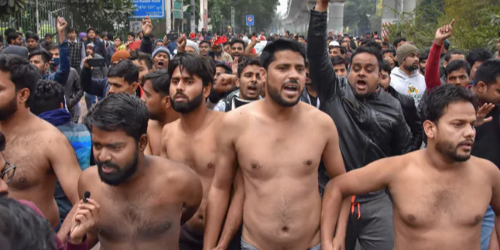After Delhi Clashes, A Night Of Student Protests Across India

Protests swept campuses across the country against the police crackdown at Jamia Millia Islamia after Sunday evening's violence over the new citizenship law. Students at the Aligarh Muslim University clashed with the police after their solidarity march was stopped. By midnight, Hyderabad's Maulana Azad Urdu University and the Banaras Hindu University raised their voices. In Delhi, hundreds gathered outside the Police Headquarters in response to a call from the students of Jawaharlal Nehru University. The trouble started Sunday evening after a protest march by the Jamia students ended in a pitched battle with the police, vandalism and torching of vehicles. The police, which used batons and teargas to contain the violence, later barged into the university and detained around 100 students. All the detained students were released around 3:30 am.
Here is your ten-point cheat sheet on this big story:
1. Around midnight, students at Hyderabad's Maulana Azad Urdu University and the Banaras Hindu University held protest marches.At Kolkata's Jadavpur University, the students held a midnight march through the neighbourhood. Students of the Maulana Azad Urdu University also demanded that their exams be postponed.
2. Demanding immediate release of detained students, hundreds gathered outside the Delhi Police Headquarters close to midnight, defying the freezing cold. The arterial road outside the headquarters was completely blocked by protesters and the police was standing ready with tear gas and water cannons in case the situation goes out of hand. The Delhi Police, around 3:30 am, said all the detained students have been released, following which the protesting crowd outside the Police Headquarters dispersed.
3. The escalating protests had hit the prestigious Aligarh Muslim University first, with the students, bent on holding a solidarity march, clashing with the police. Ten policemen and around 30 students were injured and the police demanded that the students vacate the hostels. Internet has been blocked in the city and the university closed till January 5.
4. The protest march had started from the Jamia Millia Islamia on Sunday evening and was expected to end at Jantar Mantar, the designated area for protests in the national capital. But violence started soon after. In full view of television cameras, the mob clashed with the police and set fire to buses and two-wheelers. In addition to students, several policemen including senior officers were injured. One of them is in the Intensive Care Unit with severe head injuries.
5. Later in the evening, the police detained around 100 students. "The police have entered the campus by force, no permission was given. Our staff and students are being beaten up and forced to leave the campus," said Waseem Ahmed Khan, Chief Proctor of the university.
6. Senior police officer Chinmaya Biswal told NDTV that the police entered the university only after the violent mob went inside and started throwing stones. "We were checking from where these violent activities were taking place," he said.
7. Jamia students distanced themselves from the violence and some officers of the Delhi police privately admitted that local thugs were responsible for it. In a statement, the students said, "We have time and again maintained our protests are peaceful and non-violent." The violence "by certain elements" was an attempt to vilify and discredit genuine protests, they said.
8. The trouble hit the metro services, with five stations on the city's Magenta Line - where the university is located - being closed down. Road traffic was also diverted from the area. In a Hindi tweet, Delhi's Deputy Chief Minister Manish Sisodia declared that all schools in the south east district areas including Jamia, Okhla, New Friends Colony and Madanpur Khadar, will remain closed on Monday.
9. In a tweet, Delhi Chief Minister Arvind Kejriwal has condemned the violence. "Spoke to Hon'ble LG and urged him to take all steps to restore normalcy and peace. We are also doing everything possible at our end. Real miscreants who caused violence shud be identified and punished," a second tweet read.
10. Violence had scarred parts of the country since the citizenship law -- meant to facilitate grant of citizenship to religious minorities from Pakistan, Afghanistan and Bangladesh living in India -- was passed. Much of the violence had taken place in the northeastern states, Bengal and Delhi. Earlier on Sunday, at an election rally in Jharkhand, Prime Minister Narendra Modi congratulated the people of Assam for "staying away from violence".
Do you think student's protest against the police is correct?
- 413
- Leave a comment



